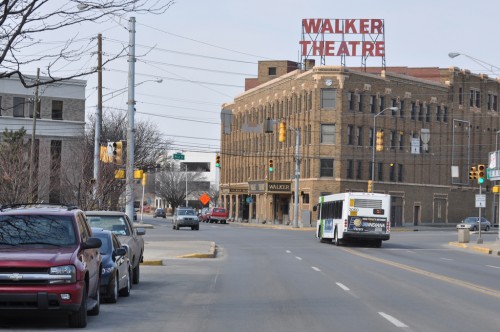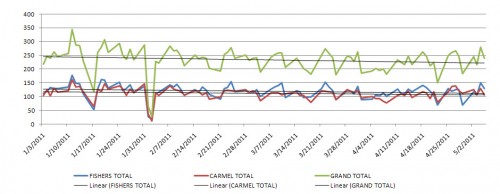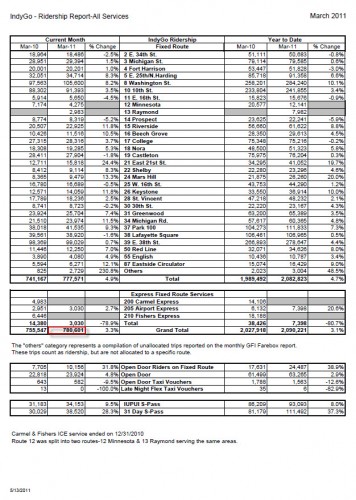
When people’s daily budgets get compromised by our wonderfully fickle gasoline prices, it creates an opportunity for people to make a choice; that choice being whether to drive the car or ride the bus to work. For some in Indianapolis, this is a viable option. Living close enough to a bus route in these days can be the proverbial diamond in the rough. Compared to filling up and paying a parking fee, a bus fare seems like a great value; if you don’t mind bending your schedule to the bus’ schedule. As of the penning of this blog, numerous filling stations in the Indianapolis are in the $4.10 – $4.20 range. I’ve seen higher and lower.
In light of the current gasoline prices, I thought it would be a good study to see how much those prices have affected transit ridership numbers in the Indianapolis area. For the purposes of this post, I got in touch with Ehren Bingaman of CIRTA and Samantha Cross & Sarah Knight at IndyGo all of whom were generous enough to share the ridership numbers of their respective services over the past couple of months with me.
CIRTA in cooperation with Miller Trailways facilitate the Commuter Expressbuses which operate from Carmel & Fishers to downtown Indianapolis. IndyGo obviously, is the municipal provider of public transportation in Indianapolis offering over 30 fixed routes.
Commuter Express

Looking at the data, it appears that demand has been relatively flat. There appears to be a slight uptick recently, but it may take longer to accurately track this trend. Observing the data, it appears that the commuter express service is good for 200-300 rides a day. Maximum boardings occurred early in the service’s life cycle and was nearly 350 boardings. It remains to be seen whether continued pressure on people’s wallets will affect the Carmel & Fishers residents desire to leave the car at home and save some money. The fact that this is a minimalist service may have something to do with the trend in which gasoline prices have seemed to not affect any ridership changes. The service in it’s current form is also in it’s infancy having transitioned from IndyGO and $3 fares to the current service and increased fare. The Carmel & Fishers services both offer 3 departures for downtown each morning and return trips in the evening.
IndyGo

Trending IndyGo’s numbers is a bit taxing. There are a couple of ways to track their data and they involve year over year changes and month to month changes. In summary, short term habit changes driven by an increase in gasoline prices did not seem to materialize from March to April.Indeed, a fall of nearly 29K boardings was observed not counting the Green Line (click attached tables to enlarge). However, overall ridership is up over the prior year which is a good sign. Next, 2008 was when IndyGo saw it’s highest boardings (measured over the year). 2008, if you all remember, was also the last time that $4 gasoline reared it’s ugly head. Then, people were not as prepared for this shock as they were this year. Additionally, employers had not yet shed the millions of jobs that were to come. The figures for March & April in 2008 respectively, were 749,846 & 816,243. March 2011 clearly exceeds 2008’s numbers but April fell woefully short. It should also be noted that there were additional buses on the 17 (15 minutes peak), 37 (20 minutes peak) & 55 (30 minutes peak) in 2008.

Conclusions
Why didn’t transit boardings increase from March to April? Was it because of record rainfall through the month that prevented choice riders from standing in the rain? Have choice riders made more room in their budget for gasoline? Do 30 minute head ways (sometimes more) combined with the bad weather and inadequate transit shelters cause choice riders to choose their car? Are there less employees relying upon public transit at this point and who have made enough room in their budgets for the additional cost of gasoline? Have suburban commuters kept up with the changes in the express routes and simply do not know that they are still an option? At this point, it would seem that these may be the biggest determining factors here in Indy and $4 a gallon gasoline does not trump those factors. Perhaps May will dry up a bit, and a more accurate barometer of ridership can be seen.
As you know, gas price is just one factor. Other things are in the way of more people getting on the bus. Although I hope that higher gas prices get more people on the bus, at the same time I almost don’t want to point to that as a main reason for why we need better mass transit. First, gas prices go up and down, and they are hard to predict even in the long run. Secondly, the answer to high gas prices in the long run might be a more efficient car vs. mass transit, and then we lose an opportunity to tell people that there are other more important benefits of mass transit.
However, I hope you follow up with this data at a later date. I think doing an annual comparison would be more meaningful. If anything, high gas prices can jump start interest for mass transit, but then the important job is to explain to people all other benefits of developing mass transit.
My thoughts after reading your conclusion section
I can answer why I haven’t chosen to ride transit as much as I could have with higher gas prices:
1)Standing in the rain sucks, especially when all of the stops I get on at to and from work have no shelter
2)It’s worse when there are 30+ minute headways, with post-work rush hour causing further delays most times I’ve ridden – more time standing in the rain under no shelter.
3) my commute is short enough (4 miles, 12 minutes) that the price of gas STILL doesn’t make it cheaper to ride the bus when fares are $1.75 one way. Sure, it’s cheaper if I get a monthly pass but probably still not enough to offset the gas price for my short commute. ALSO I jsut CAN’T take the bus on Thursdays, so I have to choose between a monthly garage downtown OR a monthly bus pass.
That’s just me. I’m probably a corner case with #3, working downtown and living on the near eastside.
why don’t you just ride a bike then on clear weather days since you only have to go 4 miles (16 minutes on a bike).?.?
I could go into more detail, Curt, but IndyGo takes some getting used to. When I was between cars, it probably took me 3-4 days to really nail down the routes, when I needed to switch busses, and all that jazz.
@Kyle: Because then what do I do on Thursdays? I go to a bar for a ‘bar night’ with friends every thursday and usuallly am there until 11pm. I don’t feel it’s safe to ride my bike from the SW corner of downtown to the near eastside at 11pm in the pitch dark.
Also, I pay for a monthly garage pass for work. If I bike every day but still then need to drive on Thursdays, I’m left having to pay a daily rate 4 times a month (sometimes 5) that ends up being more than my portion of the monthly pass not covered by my company.
You can see that it financially just doesn’t make sense.
well you just got to do what is most economical for you to do…for me if its a nice day i would ride to work…not sayin’ that you have to do it everyday, maybe like once a week…
Clear and simple: the bus doesn’t go where I (and most of my friends, family and colleagues) need it to go in a reasonable amount of time. I have seen first hand paople starting to carpool a LOT more in the pst three months.
It would be intersting to see if IndyGo has had more website traffic on their trip-planner… might point to there being more interest, but still not able to get where it’s needed.
It would also be good if IndyGo had a way to suggest a route – to put in a start point and destination and have them track where their money and routes might make more sense. Just a thought.
Bike to work day tomorrow!
Branding, branding, branding.
Buses have a stigma in Indianapolis – based partially on facts (inadequate bus supply = longer times, route factors, etc.) and partially based on bad marketing.
Increased gas prices have offered a lovely opportunity to promote choice ridership. But no one took obvious advantage of that opportunity. Getting people to try riding (and to make those early attempts positive) will take some effort, but it has to be done if we want to increase choice ridership.
I think some of you are missing the point about this study. Yea, the routes can take some time to figure out. Yes, there could be better overheads and I challenge the branding. There is nothing wrong with the branding, its the level of service.
.
In 2008, there was irrefutable evidence that people flocked to the bus when gasoline prices rose to $4 a gallon. From a paragraph above:
.
March 2008: 749,846
.
April 2008: 816,243
.
That is one heck of a gain and hard to say that it was choice riders simply deciding. So this talk about buses being slow, dirty or hard to figure out while true, were all factors that were taken into account and overcome in 2008. For apparently other factors, it was NOT the case this year.
I agree with the comment “Buses have a stigma in Indianapolis” because that’s really the main point here. Light Rail (no matter how inefficient at first) is perception changing. Buses are not. Buses actually need a Light Rail system(no matter how small or complex the system is) to be efficient. And it works both ways…the systems both need to exist to be functional. This is particularly true for sprawling Indy.
Could we all think about and define the word INVESTMENT for the community for once? We could choose: low taxes (to support the suburbs), large & outdated government, sports & conventions(which is why downtown actually exists), or higher taxes(o build up infrastructure beyond just super roads). Hmmm, which one would most likely attract people to want to live and work in Indianapolis?